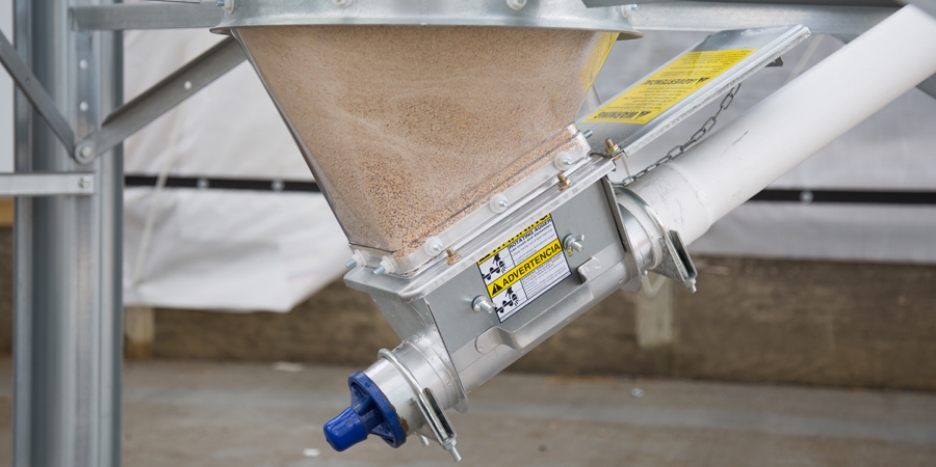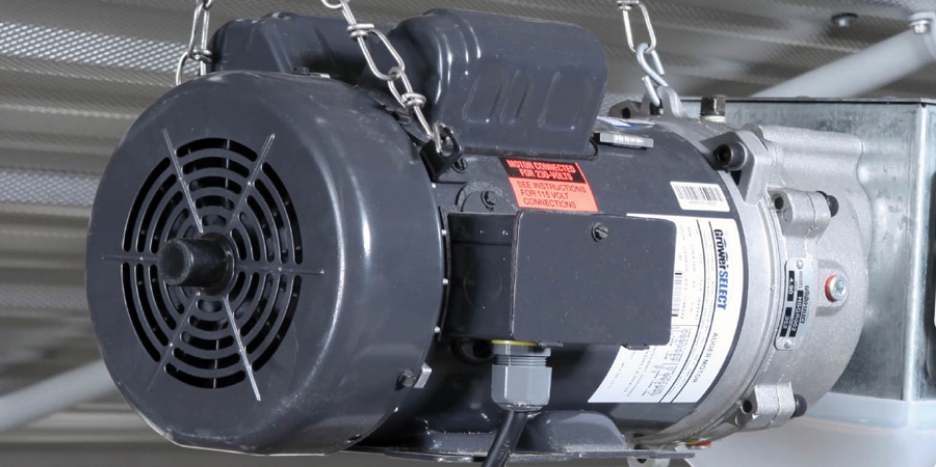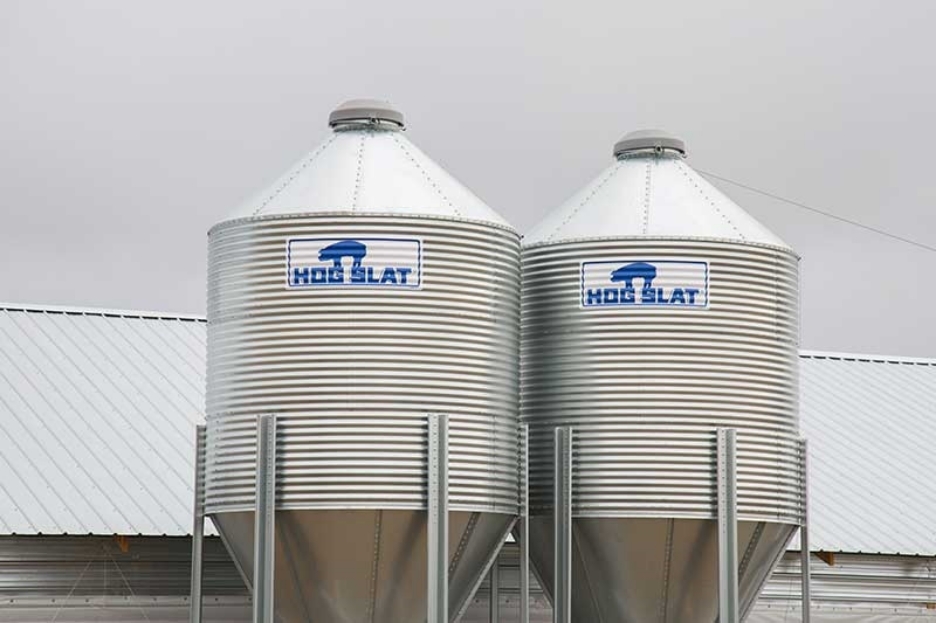Blog posts tagged with 'hog slat®'
Checking the motor plates offers valuable information when comparing two different motors.
 Hog Slat bins feature the industry's heaviest galvanized coating.
Hog Slat bins feature the industry's heaviest galvanized coating.
Steel corrosion, commonly referred to as rust, is an oxidization process occurring when iron in steel is exposed to oxygen and water. Rust causes steel to thin over time, reducing its strength and causing product failure.
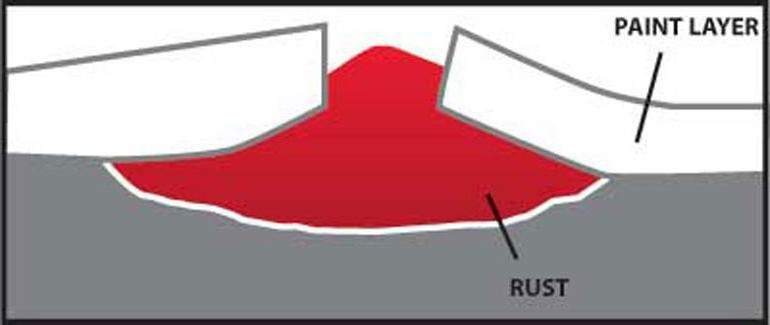 Paint coating protects steel from elements until damaged.
Paint coating protects steel from elements until damaged.
Any coating, which provides a barrier to moisture and oxygen, protects steel from corrosion. A painted surface provides an effective barrier until it is broken allowing moisture and oxygen to come in contact with the steel beneath. Rust develops at the breakage point and can even extend under the protective paint barrier.
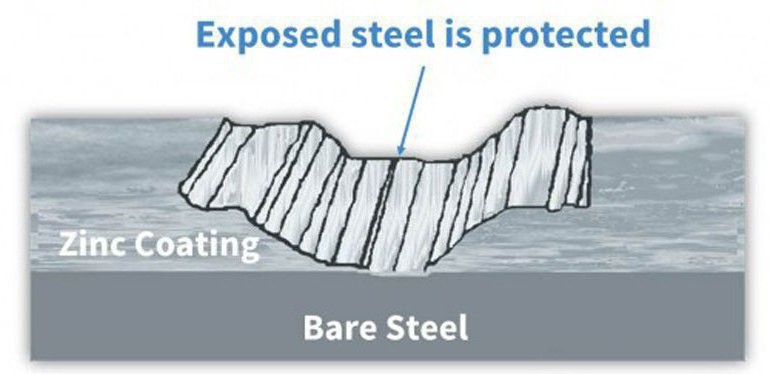 Galvanized coatings protect steel even when damaged.
Galvanized coatings protect steel even when damaged.
Similar to paint, a galvanized coating forms a protective barrier to protect steel from moisture and oxygen. Galvanized coatings also provide a second method of protecting steel by electrochemically "sacrificing" the zinc in the present of corrosive elements. In other words, the zinc corrodes, until it is depleted, instead of the metal underneath. Because it is physically bonded to the metal, galvanized coating does not allow rust to extend beneath its surface.
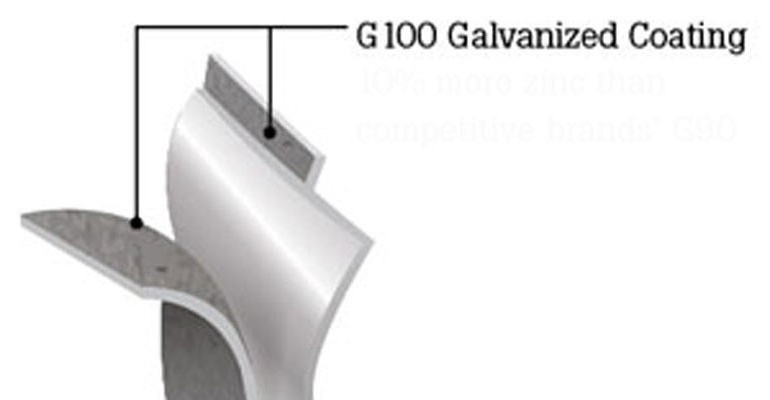 Heavier G100 galvanized coatings offer 10% longer service life.
Heavier G100 galvanized coatings offer 10% longer service life.
Galvanized coatings are expressed in ounces per square ft with conventional coatings designated as G30, G40, G60, and G90. These refer to thickness of .30, .40, .60 and 90 oz./ft2, respectively. Corrosion resistance is directly proportionate to the amount of zinc coating on the steel. Therefore we would expect the service life of G90 steel to be roughly three times that of G30 in the same environment. Likewise, increasing the galvanized coating on a feed bin from G90 to G100 increases the bin's service life by 10%.
Galvanized steel is an excellent choice for use in feed bin fabrication, as it does not degrade when exposed to the sun's ultraviolet rays like painted coatings or poly bins.
In addition to heavier galvanized coatings, Hog Slat bins are manufactured from stronger Grade 55 steel, come with an improved ladder design and water deflecting Weather Edge™. Every bin is backed by an extended 5-year warranty. To see more go to Bulk Feed Bins.
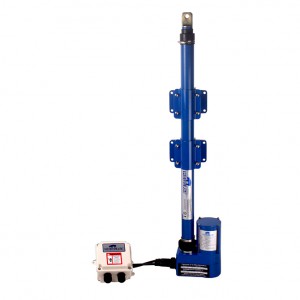
Your reaction on seeing the PRICE of Hog Slat’s Vent Actuator will probably be to dismiss it as a low quality item. You get what you pay for.
Don’t let the price fool you.
The Vent Actuator is a great example of Hog Slat’s engineering expertise, combined with global sourcing and lean distribution chain.
Engineering added features to increase the useful life of the unit.
24″ stroke length with a maximum speed of 1/4″ per second and adjustable limit switches.
Built-in potentiometer sends feedback to room controller to position air inlets.
800 lb. payload
Increased protection of interior electrical components with clamped extension boots and motor seals. Overall, the Actuator’s Internal Protection Rating is 65 vs. competitive brands with ratings of only 53. (See What is an IP rating?)
Hog Slat’s lean distribution chain model direct sources products and delivers them to the farm without an expensive and outdated dealer network. (See eliminating margin stack)
All in all, a great product at a great price.
The Right Kind of Sticker Shock. For ordering information go to HS667-24.
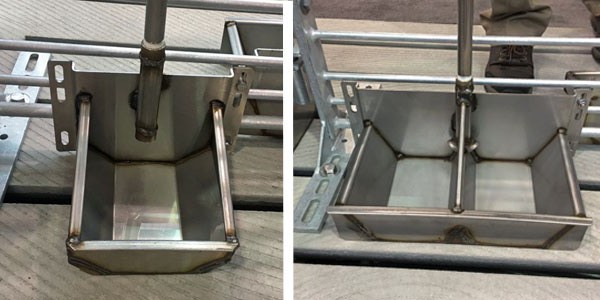
Single and Double Welded Cups
Hog Slat highlighted an additional watering option for finishing pigs at the 2016 World Pork Expo. This all stainless steel welded cup is available in single and double models and designed with several features producers will appreciate.
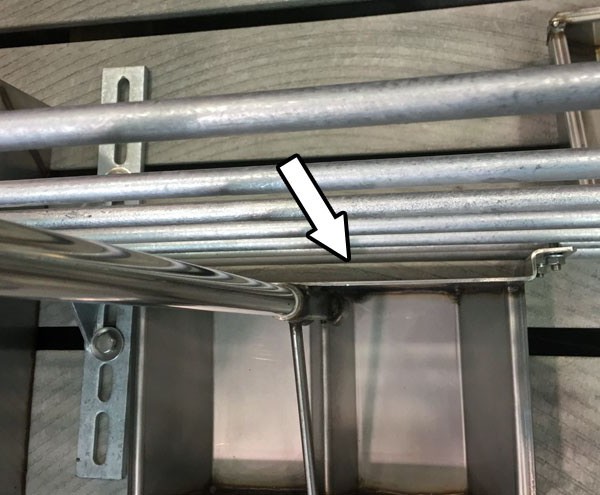
Note formed gap in back plate to prevent manure buildup.
The back plate of welded cup is formed with a gap off the gate to allow any manure accumulating there to be easily washed out. This prevents premature rusting of gate rods common with cups mounted back to back without this gap.
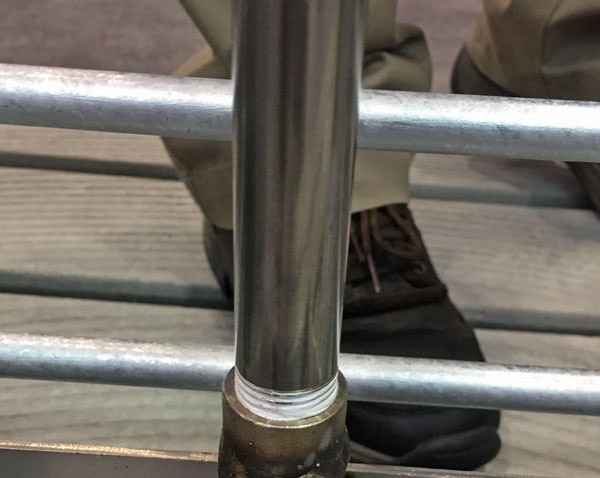
Two-piece water pipe.
The unique design of the two-piece water pipe allows for easy replacement if it should ever become damaged or bent. The separate ½”x 48” long pipe installs into a female coupler on top of the cup. A specially designed bracket is included to mount the pipe to the top angle on a gate.
Mounting cups back to back is simple with four bolts or single cups can be mounted with a U-bolt around a horizontal gate bar.
To order go to www.hogslat.com, stop at a local Hog Slat store or call 800-949-4647.
The size of individual sow farms continues to increase; just a few years ago 2,400 head units were considered large, but new sow farms under construction this year range between 5,000 to 14,000 head in size.
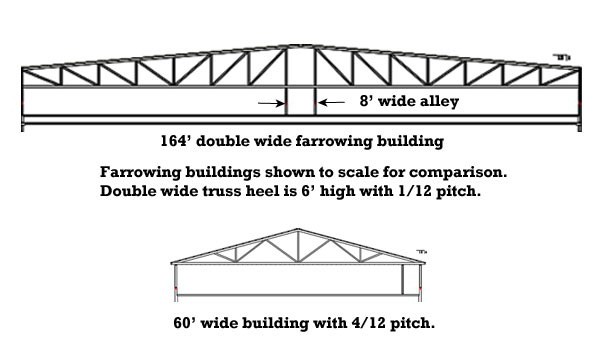
Building cross-section comparison
Designing the central production facility into two or three larger buildings has many advantages including smaller land requirements, less underground utilities to bring to the site, shorter roadways to build and maintain, fewer walkways between buildings and less linear footage of exterior building walls.
Because of increased pig capacities and the desire to minimize the number of buildings, it was necessary to increase the buildings widths up to 190 feet. Instead of the 4/12-pitch roof used on standard farm buildings, these jumbo-wide facilities utilize a two-piece rafter with a 1/12-pitch roof line resting on a center support wall in the middle. Almost 6 feet high at the heel with a center height of 13 feet, the rafters are designed more like a large floor joist. The outside appearance resembles a steel frame building more than conventional wood framed structures.
Breeding/ Gestation
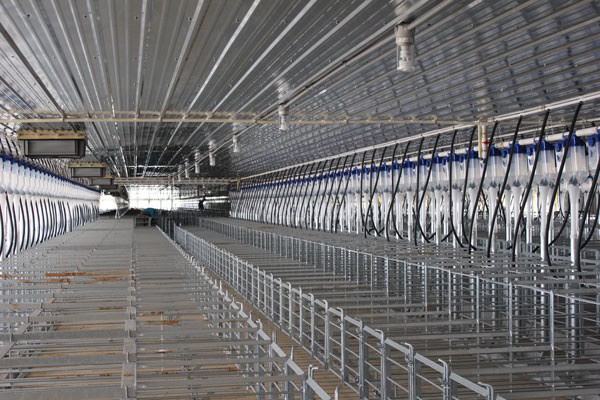
Galvanized gestation stalls
Totally slatted flooring is a common feature of newly constructed B&G buildings. While past layouts consisted of a solid laying area with slat sections in the rear of the pen or stall only, new construction plans incorporate slats over the entire floor with stainless feeding troughs fastened in place. This arrangement allows long-term flexibility to reconfigure the pen layout in the future if needed.
Group housing with stanchions is the predominant type of housing under construction this year. Largely through trial and error, the industry seems to have settled into pen configurations containing eight to twelve sows. This pen size permits closer grouping by size and condition and promotes easier visual inspection.
Whether the production system chooses gestation stalls, stanchions, or ESF, most equipment is specified with hot-dipped galvanized equipment instead of painted finish. The extended equipment life provided by the galvanized finish makes this an economical business decision.
One advantage reported with stanchion systems is longer equipment life resulting from moving the water away from the front of the stanchions. Locating a cup or swinging water pipe with nipples in the center of the pen reduces the deterioration of feed pipes and stall fronts by minimizing water contact with these areas.
Farrowing
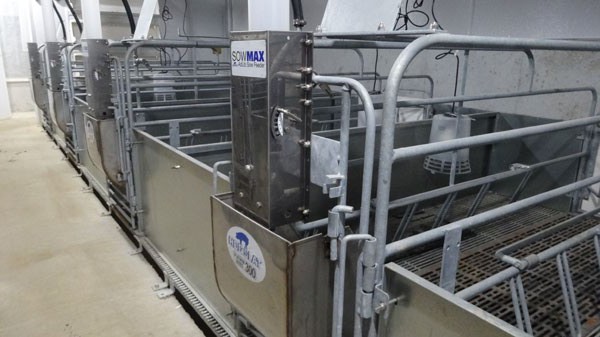
Large pen farrowing crates with SowMAX feeders
Jumbo style layouts permit designing a double farrowing building with an extra wide 8-foot center alleyway to aid in animal and people movement between rooms.
Almost every new construction project increases the length and width of the farrowing crates and creep area from the standard 5′ x 7′ footprint up to 6’ wide by 8′ long, with some systems choosing 8’6″ long crates. Longer framed sows and reduced piglet crushing rates from using wider pens have driven this trend. Again, the equipment will have a galvanized finish with a combination of cast iron, TriDek, or plastic slats for flooring choices.
Most production systems will incorporate some provision for ad-lib sow feeding. Besides reducing farm labor, ad-lib sow feeding is the most efficient method for feeding individual sows to reach full milk production potential. The type of systems can range from electronic transponder metering devices to sow activated hopper type feed dispensers.
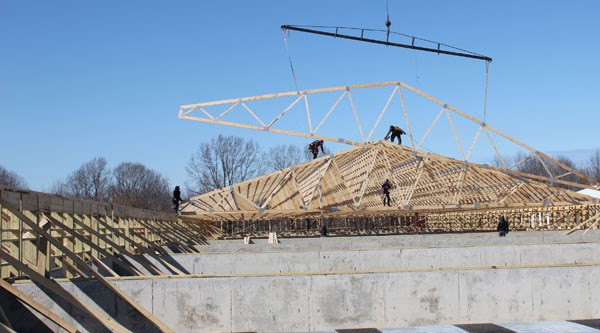
Swinging rafters on new farrowing house
Projects of this size require builders with an expanded skill set. A builder must be able to provide professional project management, understanding of regulatory issues, and increased insurance coverage. It is also critical for any construction firm undertaking projects of this size to have sufficient financial backing and the ability to manage large cash flows.
For more information about Hog Slat’s construction projects and swine production equipment offerings, contact your nearest sales representative by clicking here.
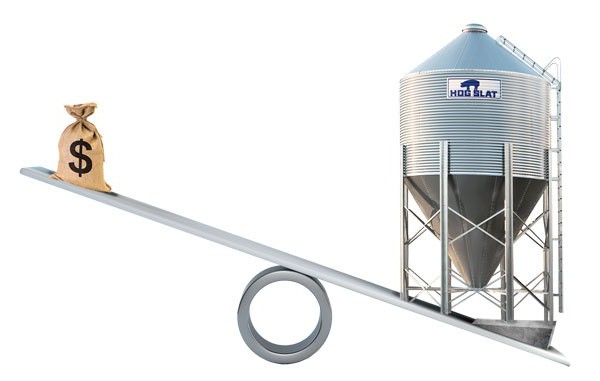
How can we make the claim of selling the strongest, heaviest feed bins on the market at the best possible price to swine and poultry growers?
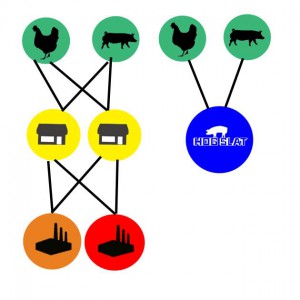
Traditional multilevel supply chain vs. Hog Slat’s Direct Distribution
Simple. Our direct distribution system eliminates the additional markup that dealers have to add to the bin’s price. Instead, that money goes back into building a stronger bin manufactured from heavier steel. These longer lasting bins are built with 5-10% more steel, by weight, than competitive brands.
Compare the features.
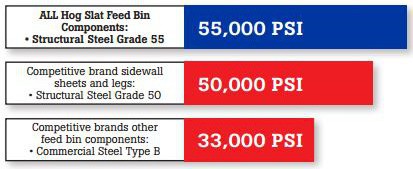
Most manufacturers only use 50,000 psi structural steel for the bin sheets and legs to reduce costs. Hog Slat bins are constructed entirely of GRADE 55 structural steel. The bin sheets, legs, roof sheets, bottom cone sheets…the entire bin.
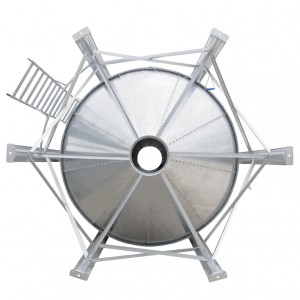
Heavy, dent resistant bottom cone sheets.
The bottom cone sheets of a bin are subjected to extra abuse from hammers and mallets used to dislodge bridging feed. That’s why we used thicker steel to resist dings and dents.
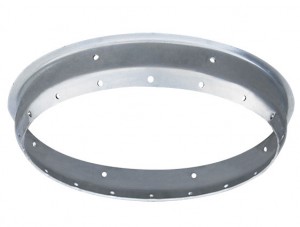
Heavy 10 gauge collar
We build the bin collar out of heavier 10 gauge steel to eliminate having to add additional reinforcing collars. The collar is stamped to reduce variations in dimensions compared to rolled or spun collars.
Every Hog Slat / Georgia Poultry bin is manufactured in-house for complete control of raw material purchasing and manufacturing operations. Our facility includes state-of-art rolling, stamping and finishing machinery to ensure precise fit and finish.
Get a quote on your next bin and see for yourself. Call 800-949-4647, go online www.hogslat.com or stop in at a local Hog Slat or Georgia Poultry store. (click for store locator)
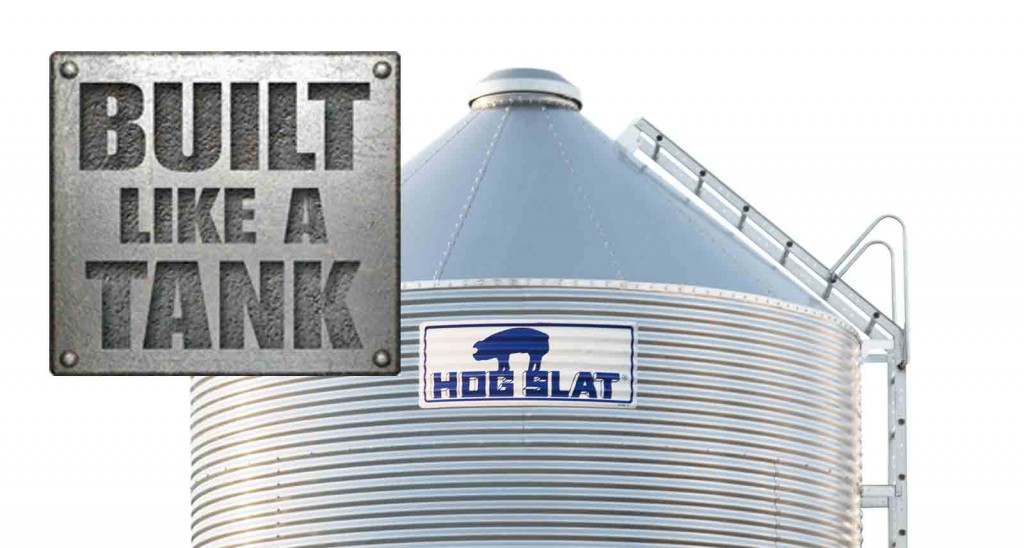
Heavier bins, Stronger bins. Bins designed to last longer.

It starts with the selection of steel. Most feed bins are built from a mixture of steel grades. The sidewall sheets and legs are manufactured from Grade 50 structural steel (50,000 psi) while the other components are produced using a commercial grade type B steel (33,000 psi) The entire Hog Slat bin is manufactured using only Grade 55 Structural Steel with a superior strength of 55,000 psi.
We use stronger steel in the smallest part of our bin than the competition does in their most critical components.
We didn’t stop there.

We also use heavier gauges of steel in every part of the bins; including thicker bottom cone sheets, that resist dents from hammers, to bin collars over four gauges thicker than competitive brands.
Our state-of-the-art, in-house manufacturing allows us to produce heavier, stronger products with precision for ease of assembly and proper fit along with features designed to protect both the operator and the stored feed.
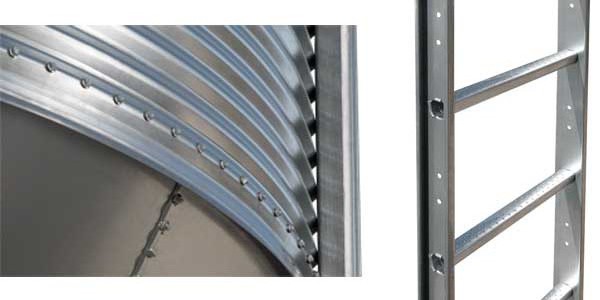
Our improved WeatherEdge™ design directs water away from the hopper, and rounded trapezoid ladder rungs provide for secure footing, exceeding OSHA safety standards. Hog Slat feed bins also feature a spring loaded lid that folds flat, below the fill ring, to protect it from damage during filling.

We are so confident of the quality of the bins that we offer the industry’s best warranty, an extended FIVE-YEAR warranty.
In addition to the great design and durable construction, one of the most important features of our feed bins is the local assembly, delivery, and service provided by our extensive store network. Our local stores selling directly to the end-user allows us to help eliminate extra costs and add value that makes choosing your next feed bins a simple choice.
Longer-lasting bins, a better warranty and local service.
Get a quote on your next bin and see for yourself. Call 800-949-4647, go online www.hogslat.com or stop in at a local Hog Slat or Georgia Poultry store. (click for Store Locator)
Management expert Peter Drucker is often quoted as saying that “you can’t manage what you can’t measure.” We believe this is particularly true when it comes to developing, improving and testing ventilation fans.
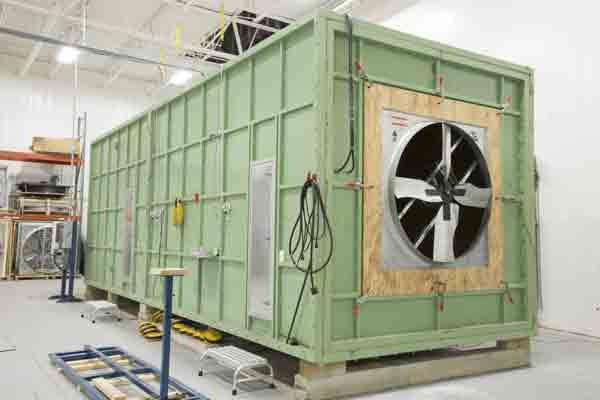
Hog Slat’s Wind Tunnel
Hog Slat’s AirStorm and Windstorm ventilation fans are designed and tested using an Airflow Performance Test Chamber, or as it more commonly known, a Wind Tunnel. Measuring 10′ x 10′ x 28′ long, the Wind Tunnel was constructed according to AMCA standard 210 and installed at the Clinton, NC facility in May 2015.
Fans to be tested are fixed in place on one end of the Wind Tunnel.
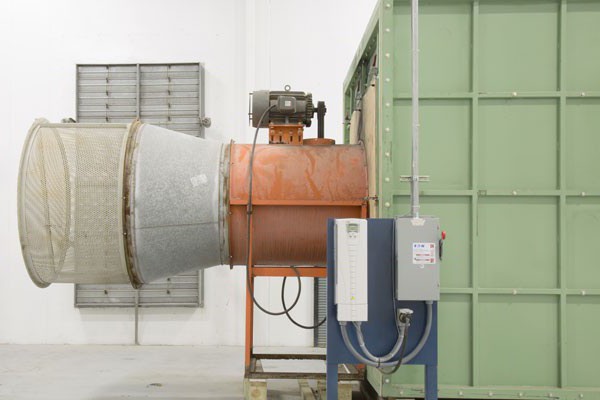
Air Forcing fan powered by a 20 HP motor
A 48″ axial vane fan, powered by a 20 hp motor, located on the opposite end of the tunnel, forces air into the chamber.
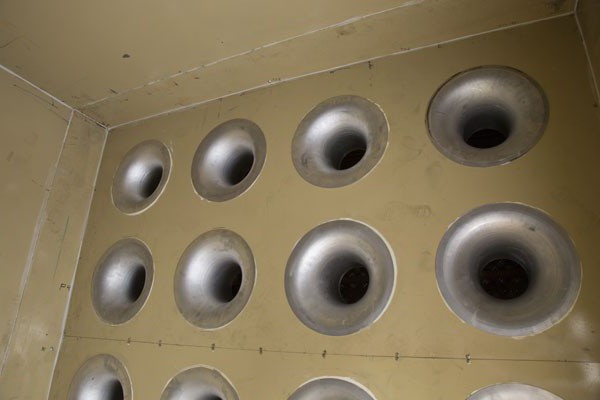
Nozzle Wall
After passing through a series of mesh straighteners, the air is then forced through a nozzle wall consisting of metal cones that can be opened and closed to change available square inches of space.
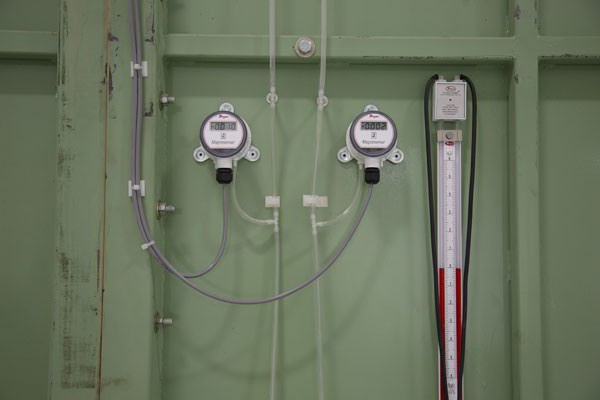
Pressure transmitters feed data to the automated recording system.
Two devices, called Differential Pressure Transmitters, measure and record the static pressure differential on each side of the nozzle wall. To maintain precise accuracy, the transmitters are calibrated monthly and are also returned to the manufacturer for a factory re-calibration once per year.
One of the key features of Hog Slat’s test chamber is the automated recording system that records data without any manual input from an operator. The Wind Tunnel is ramped up from zero to maximum static pressure while up to two data points per second are recorded in real time. This automated recording system is a custom program developed by a team from Hog Slat’s engineering group. This allows Wind Tunnel technician, Matt Parker, to supply the engineering group with a complete fan performance graph instead of limiting the information to only a few selected data points.
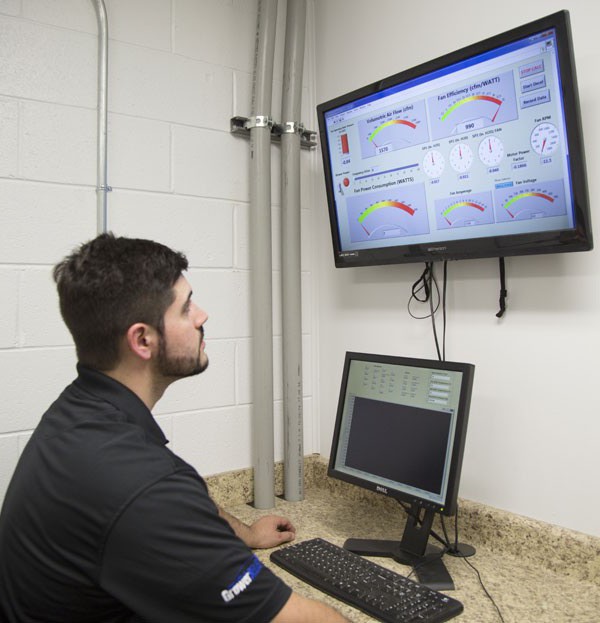
Technician Matt Parker views display screen readouts.
Lead engineer for ventilation products, Tyler Marion explains; “Having a Wind Tunnel in-house allows us to quickly break down a fan by critical components and test multiple variables quickly. We are able to test different motor/fan combinations, shutter designs, and cone styles to constantly improve the fans Hog Slat delivers to our customers.”
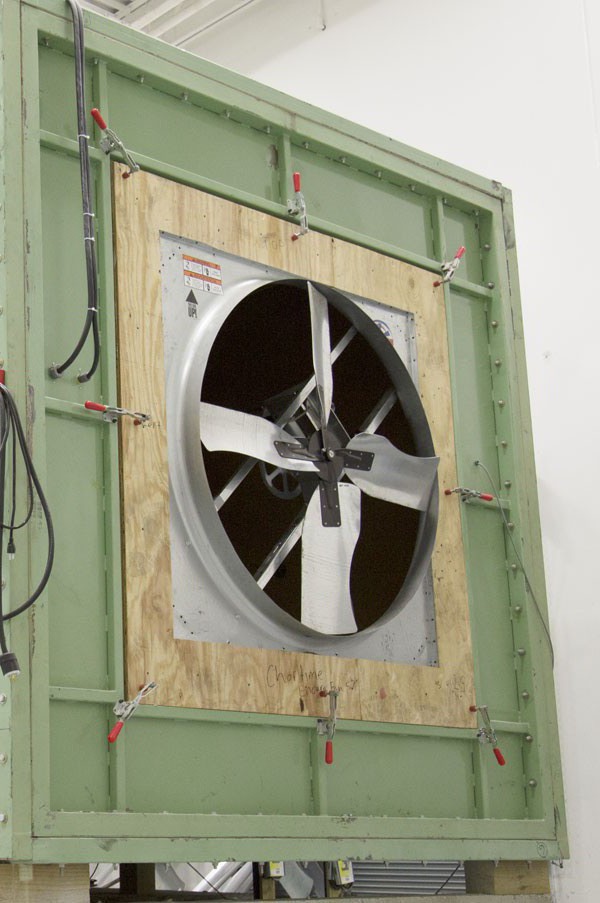
QC testing fan blades
Hog Slat’s Wind Tunnel is not only used for fan testing and development, it also serves as a Quality Control check on products received from suppliers. The photo above shows a galvanized prop mounted in standard fan ring. In this case, the initial run of product from the vendor is being checked against the approved sample. This testing continues for each production run to ensure the same performance levels from lot to lot. QC checks are also run for completed fans pulled from inventory and checked against published standards for airflow, CFM/watt and motor amperage.
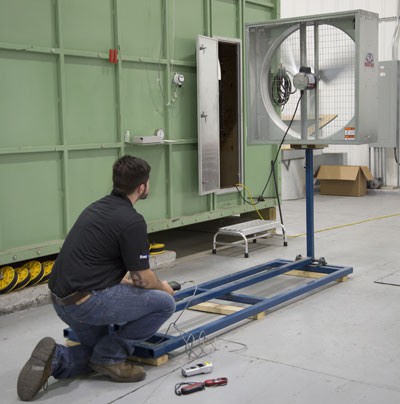
Matt tests a Windstorm 36″ Box Fan using the Thrust Tester.
A new addition to our fan testing equipment is the device called a Thrust Tester. The Thrust Tester measures the amount of thrust (lbf or pounds of force) a stir or circulation fan develops. It also measures the thrust efficiency ratio of a fan by dividing the lbf by kWs used. Although the Thrust Test is a stand-alone unit, it is tied into the Wind Tunnel transmitters to record the data. Matt also records centerline velocity at distances five times the prop diameter.
To see more on Hog Slat’s complete line of AirStorm fiberglass and Windstorm galvanized ventilation fans go to www.hogslat.com or call 800-949-4647.
- 2026
- 2025
- 2024
- 2023
- 2022
- 2021
- 2020
- 2019
- 2018
- 2017
- 2016
- 2015
- 2013












 Україна
Україна Méjico
Méjico